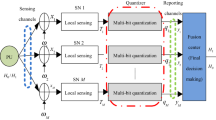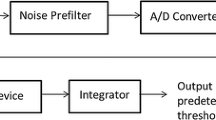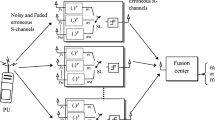Abstract
In this paper a pretty new concept of non-uniform quantized data fusion (N-QDF) rule reducing control channel data overhead has been proposed for energy detection based cooperative spectrum sensing scheme in cognitive radio networks. To strike a balance between efficient detection performance and less complexity, the network has to allow soften hard or quantized data fusion (QDF) technique though this technique incurs few bit overhead on the control channel from each user. Again lower bit QDF causes loss of more information, where as higher bit QDF increases detection probability at the cost of some extra bits per user. Here lies the beauty of NQDF scheme which uses variable number of bits: more number of bits for lower energy region—thus increases detection probability for a given false alarm, and less number of bits for higher energy region—thus data rate gets saved which in turn alleviates control channel overhead. A holistic simulation study has been done in this very paper where the performance of variable bit NQDF scheme is compared with different uniform bit i.e. 2, 3, 4, 5 QDF with respect to different parameters to validate our proposed scheme.








Similar content being viewed by others
References
FCC, ET Docket No 03-322 notice of proposed rule making and order, Dec 2003.
Banerjee, J. S., Chakraborty, A., & Chattopadhyay, A. (2018). Reliable best-relay selection for secondary transmission in co-operation based cognitive radio systems: A multi-criteria approach. Journal of Mechanics of Continua and Mathematical Sciences, 13(2), 24–42.
Chakraborty, A., Banerjee, J. S., & Chattopadhyay, A. (2017). Non-uniform quantized data fusion rule alleviating control channel overhead for cooperative spectrum sensing in cognitive radio networks. In Advance Computing Conference (IACC), 2017 IEEE 7th International (pp. 210–215). IEEE.
Akyildiz, I. F., Lee, W.-Y., Vuran, M. C., & Mohanty, S. (2006). Next generation/dynamic spectrum access/cognitive radio wireless networks: A survey. Computer Networks, 50(13), 2127–2159.
Akyildiz, I. F., Wang, X., & Wang, W. (2005). Wireless mesh networks: A survey. Computer Networks, 47(4), 445–487.
Akyildiz, I. F., Lee, W. Y., & Chowdhury, K. R. (2009). CRAHNs: Cognitive radio ad hoc networks. Ad Hoc Networks, 7(5), 810–836.
Banerjee, J. S., & Chakraborty, A. (2015). Fundamentals of software defined radio and cooperative spectrum sensing: a step ahead of cognitive radio networks. In N. Kaabouch & W. Hu (Eds.), Handbook of research on software-defined and cognitive radio technologies for dynamic spectrum management (pp. 499–543). Hershey, PA: Information Science Reference.
Banerjee, J. S., & Chakraborty, A. (2014). Modeling of software defined radio architecture and cognitive radio, the next generation dynamic and smart spectrum access technology. In M. H. Rehmani & Y. Faheem (Eds.), Cognitive radio sensor networks: Applications, architectures, and challenges (pp. 127–158). Hershey, PA: Information Science Reference.
Banerjee, J. S., Chakraborty, A., & Karmakar, K. (2013). Architecture of cognitive radio networks. In N. Meghanathan & Y. B. Reddy (Eds.), Cognitive radio technology applications for wireless and mobile ad hoc networks (pp. 125–152). Hershey, PA: Information Science Reference.
Haykin, S. (2005). Cognitive radio: Brain-empowered wireless communications. IEEE Journal on Selected Areas in Communications, 23(2), 201–220.
Yucek, T., & Arslan, H. (2009). A survey of spectrum sensing algorithms for cognitive radio application. IEEE Communications Surveys and Tutorials, 11(1), 116–130.
Jiang, T., & Qu, D. (2008). On minimum sensing error with spectrum sensing using counting rule in cognitive radio networks. In Proceedings of 4th annual international conference on wireless internet (WICON’08), Brussels, Belgium (pp. 1–9).
Digham, F. F., Alouini, M.-S., & Simon, M. K. (2003). On the energy detection of unknown signals over fading channels. In Proceedings of IEEE international conference on communications (Vol. 5, pp. 3575–3579).
Chakraborty, A., & Banerjee, J. S. (2013). An advance Q learning (AQL) approach for path planning and obstacle avoidance of a mobile robot. International Journal of Intelligent Mechatronics and Robotics, 3(1), 53–73.
Cabric, D., Mishra, S. M., & Brodersen, R. W. (2004). Implementation issues in spectrum sensing for cognitive radios. In Proceedings of Asilomar conference on signals, systems, and computers (Vol. 1, pp. 772–776).
Peh, E., & Liang, Y.-C. (2007). Optimization for cooperative sensing in cognitive radio networks. In WCNC 11-15 (pp. 27–32).
Unnikrishnan, J., & Veeravalli, V. V. (2007). Cooperative spectrum sensing and detection for cognitive radio. In IEEE GLOBCOM (pp. 2972–2976).
Akyildiz, F., Lo, B. F., & Balakrishnan, R. (2011). Cooperative spectrum sensing in cognitive radio networks: A survey. Physical Communication (Elsevier) Journal, 4(1), 40–62.
Zhang, W., Mallik, R., & Letaief, K. (2008). Cooperative spectrum sensing optimization in cognitive radio networks. In Proceedings of IEEE international conference on communications (pp. 3411–3415).
Ganesan, G., & Li, Y. G. (2007). Cooperative spectrum sensing in cognitive radio—Part I: Two user networks. IEEE Transactions on Wireless Communications, 6(6), 2204–2213.
Ganesan, G., & Li, Y. G. (2007). Cooperative spectrum sensing in cognitive radio—Part II: Multiuser networks. IEEE Transactions on Wireless Communications, 6(6), 2214–2222.
Mishra, S. M., Sahai, A., & Brodersen, R. W. (2006). Cooperative sensing among cognitive radios. In Proceedings of IEEE international conference on communications (Vol. 4, pp. 1658–1663).
Ghasemi, A., & Sousa, E. S. (2005). Collaborative spectrum sensing for opportunistic access in fading environments. In Proceedings of IEEE international symposium on new frontiers in dynamic spectrum access networks (pp. 131–136).
Ma, J., & Li, Y. (2007). Soft combination and detection for cooperative spectrum sensing in cognitive radio networks. In Proceedings of IEEE Global Telecommunications Conference (pp. 3139–3143).
Teguig, D., Scheers, B., & Le Nir, V. (2012). Data fusion schemes for cooperative spectrum sensing in cognitive radio networks. In 2012 Military Proceedings of IEEE international conference on communications and information systems conference (MCC). IEEE, 2012.
Banerjee, J. S., Chakraborty, A., & Chattopadhyay, A. (2018). Relay node selection using analytical hierarchy process (AHP) for secondary transmission in multi-user cooperative cognitive radio systems. In Advances in Electronics, Communication and Computing (pp. 745–754). Singapore: Springer.
Banerjee, J. S., Chakraborty, A., & Chattopadhyay, A. (2017). Fuzzy based relay selection for secondary transmission in cooperative cognitive radio networks. In Advances in Optical Science and Engineering (pp. 279–287). Singapore: Springer.
Banerjee, J. S., & Karmakar, K. (2012). A comparative study on cognitive radio implementation issues. International Journal of Computer Applications, 45(15), 44–51.
Banerjee, J. S., Chakraborty, A., & Chattopadhyay, A. (2018). A novel best relay selection protocol for cooperative cognitive radio systems using fuzzy AHP. Journal of Mechanics of Continua and Mathematical Sciences, 13(2), 72–87.
Acknowledgements
The authors deeply acknowledge the support from the Department of ECE, Bengal Institute of Technology (A unit of Techno India Group) and the department of ECE, University of Engineering and Management, and Kolkata (A unit of IEM UEM Group).
Author information
Authors and Affiliations
Corresponding author
Additional information
Publisher's Note
Springer Nature remains neutral with regard to jurisdictional claims in published maps and institutional affiliations.
Rights and permissions
About this article
Cite this article
Chakraborty, A., Banerjee, J.S. & Chattopadhyay, A. Non-uniform Quantized Data Fusion Rule for Data Rate Saving and Reducing Control Channel Overhead for Cooperative Spectrum Sensing in Cognitive Radio Networks. Wireless Pers Commun 104, 837–851 (2019). https://doi.org/10.1007/s11277-018-6054-1
Published:
Issue Date:
DOI: https://doi.org/10.1007/s11277-018-6054-1




